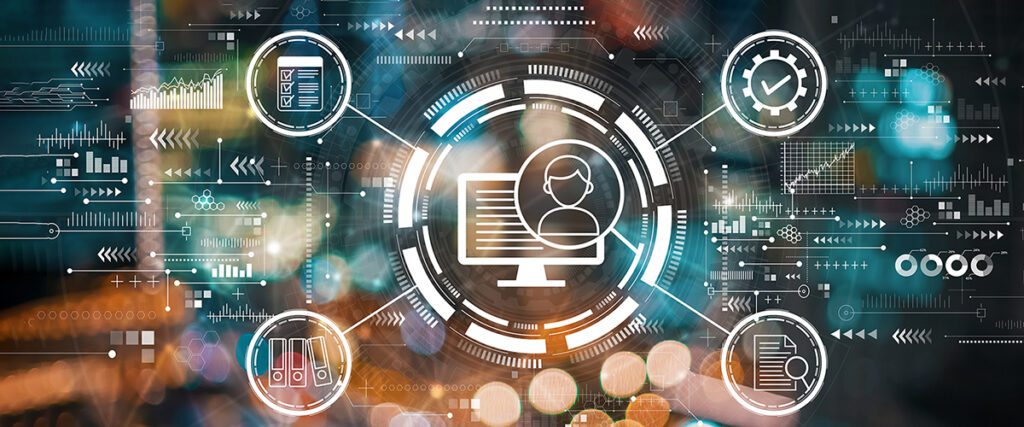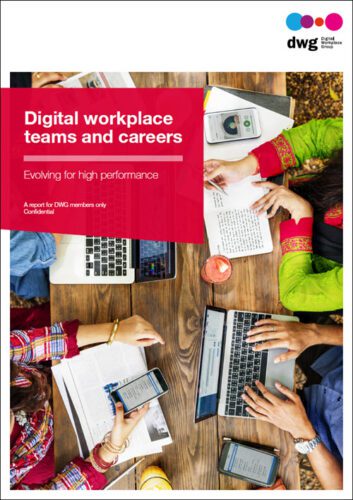DWG’s 2024 predictions for the digital workplace
There are a few DWG seasons that I just love: when we announce our award winners, when we publish our annual research programme topics, when we roll out our events calendar and when we gather for our in-person member meetings (spring and fall). Another seasonal favourite is unveiling our industry predictions. Why? Well, that’s because DWG’s industry predictions spark ambition, questions, forward thinking and sometimes even some impassioned debate within DWG membership and our wider circles.
Reflecting on DWG’s tradition of predicting industry trends
It’s hard to believe that 2024 marks the tenth edition of our digital workplace predictions, although we’ve been polishing DWG’s crystal ball since 2008, when we launched our first set of intranet predictions.
Along the way, there have been some highs and lows in performance. The all-time high score was achieved in 2018 (8.5 out of 10), while the low-point, driven by COVID, came in 2020 (6 out of 10).

To my surprise, 2023 marked the return to a high-performing year having achieved a score of 8 out of 10. Among the two clunkers were the predictions centred around the metaverse and ESG initiatives – both were eclipsed by the meteoric rise of generative AI.
| Prediction 1 | Digital headquarters move into steady-state evolution while the hybrid working tug of war continues. | ✓ |
|---|---|---|
| Prediction 2 | Digital inclusion goes beyond accessibility basics. | ✓ |
| Prediction 3 | The metaverse is the new digital archipelago of workplace experiences. | x |
| Prediction 4 | The most important skill for digital workplace teams will be navigating change. | ✓ |
| Prediction 5 | Recruitment, on-boarding and ‘early days retention’ will require business-specific digital workplace spaces mixed with in-person connections. | ✓ |
| Prediction 6 | HR will claim stewardship of the employee experience at large; digital workplace leaders need to bring their passion for connections, curiosity and experimentation. | ✓ |
| Prediction 7 | ESG programmes pressure digital workplace teams to clean up their act. It’s time to start addressing your dirty ecosystem. | x |
| Prediction 8 | Digital workplace teams will be challenged to show continued impact. Meaningful metrics will be essential. | ✓ |
| Prediction 9 | AI capabilities leapfrog a broader definition around productivity, and Microsoft is showing us that digital coaching will come at a premium. | ✓ |
| Prediction 10 | Aspiration, reinvention and innovation happen at scale with the help of a curated collection of intelligent assistants. | ✓ |
Drumroll please! DWG’s 2024 predictions for the digital workplace
In early November, I had the pleasure of unveiling DWG’s 2024 predictions for the digital workplace to our members. It was exciting to see how many members connected both with them and with each other. It even sparked a GIF war in the chat panel alongside high-energy discussions about each theme. Our members are certainly a passionate group whenever we talk about trends and insights.
And, now it’s time to share with you the 2024 predictions as you contemplate your strategic priorities for the digital workplace in the coming year:
1. Content is still king, but data is the new queen

It has long been established that content is king in the digital workplace. Content plays a crucial role in driving employee engagement, collaboration, connection and productivity. The data wrapped around such content has become an essential asset for organizations as a driver of relevancy and currency of information that feeds decision-making, problem-solving and innovation, as well as a more positive workplace experience – all of which can add up to competitive advantage.
As artificial intelligence (AI) continues to advance, data management will become an even more critical part of the digital workplace. Why? Quite simply, AI will play an increasingly pivotal role for leaders, individuals and teams by providing real-time insights for enhanced data-driven decision-making. AI will also play a crucial role in neutralizing biases that can influence decision-making.
As the digital workplace evolves, AI-powered data management and analytics tools will also become an epicentre for making informed decisions, prioritizing investments, increasing confidence in knowledge and content, and helping to deliver valuable products and services via the digital HQ.
To harness the power of data-driven decision-making in the age of AI, digital workplace practitioners will need to level up their data management practices.1 Some examples include:
- requiring a single source of truth for data
- keeping data clean
- ensuring proper data tagging, storage and lineage
- training employees and stakeholders on data use
- measuring and monitoring environmental impact
- keeping data access, privacy and security policies front and centre.
Select DWG resources:
- Engaging with data: New perspectives on digital workplace analytics (research)
- Understanding business intelligence: An introduction for digital workplace teams (research)
2. The next big thing for DEX will be shaping relational experiences

The next big thing for digital employee experiences (DEX) will be to shape relational experiences.
Employees interact with people, technology and data every day and all day long. How they do so changes based on who they are, where they are and what they need to think, feel or do. And, the more connected your employees feel with people, technology and data, the more inclined they are to lean into a process, an activity, a decision, and even commit to future action and behaviour.
Relational design is about creating human-centred experiences that connect people, technology and data. It also aims to create emotional connections and foster a sense of community and belonging, leading to increased engagement, collaboration and retention.2,3
This can be achieved through:
- social features, such as forums, chat rooms and review sections, which allow users to interact and engage with one another
- consistency and continuity, which are crucial in relational design – by creating a consistent visual identity and user experience across all products and services, designers can create a sense of continuity and familiarity, leading to increased engagement and user retention
- accessibility, another important aspect of relational design – by designing products and services that are accessible, designers can ensure they are usable by people with different assistive requirements, further enhancing the user experience
- being open to employee feedback when launching new digital tools, aligning business goals with user needs and prioritizing the user experience in the design of digital tools
- helping employees to understand how to leverage AI-powered collaboration as a new relational dynamic – it is challenging enough to use technology to collaborate person-to-person; add AI into the mix without proper support and your employees will be shouting ‘three’s a crowd’
- training employees on how to use new digital tools effectively and providing them with time to adapt to these tools, along with providing mentoring.
Digital workplace professionals can improve the employee experience through relational design by focusing on creating emotional connections, fostering a sense of community, and ensuring consistency and accessibility as well as creating an ongoing feedback loop.
Select DWG resources:
- How emotional journeys are shaping digital experiences at Fidelity International (podcast)
- Dare to un-lead: The art of relational leadership (podcast)
- The inclusive digital workplace: Nurturing digital inclusivity (part 1 of 3) (research)
3. Digital workplace impact will be assessed using AI-powered strategic insights

During our fall member meeting in Mountain View, there was quite a lot of discussion around the need for AI-powered strategic insights in 2024. There are two centres of gravity around this.
Firstly, the things that will create headspace to empower more strategic thinking, such as:
- Automating simple tasks: Help employees to be more productive and efficient by automating simple tasks, freeing up employees’ time so they can focus on higher-level tasks.
- Improving productivity: Help reduce the burden of digital friction, improve productivity and increase efficiency in the digital workplace.
- Reducing context switching: Reduce wasted time by elevating tasks and information out of the source system and delivering it directly to employees within the flow of work.
- Summarizing information: Help structure thoughts and ideas by summarizing information or content, such as meeting notes or email drafts.
Secondly, the things that will enhance performance capacity by putting valuable information at people’s fingertips, such as:
- Data-driven decision-making: AI can analyse large amounts of data and identify patterns and trends, which will help people in making smarter and more strategic decisions.
- Providing real-time feedback: AI-powered tools can provide real-time feedback to employees, helping them to improve their performance and productivity.
- Offering predictive analytics: Data analysts can use predictive analytics to identify trends and offer insights that would otherwise be hidden.
Select DWG resources:
- Measuring up: the new strategic outlook for digital workplace metrics (research)
- How to demonstrate digital workplace impact: Creating a story from the data (research)
4. The citizen developers’ movement is poised for a burst in innovation

AI is expected to play a significant role in the citizen developer movement. It is already empowering individuals to simplify complex tasks; it is also on pace to enable them to create sophisticated applications without deep technical knowledge.
The combination of AI and low-code/no-code development is already enabling individuals to build applications faster, with fewer errors. It will greatly enhance user experiences and accelerate innovation – making AI an essential tool for unleashing the potential of citizen developers.
The fusion of citizen development and AI will lead to innovation breakthroughs across diverse sectors, ushering in advancements previously thought to be unattainable. This collaboration between human creativity and AI capabilities has the potential to reshape industries, drive efficiency, enhance user experiences and enable continuous improvement.
While AI has the potential to revolutionize citizen development, there are also potential drawbacks to consider.
- These include the inability to replicate human intuition and creativity, lack of common sense, algorithmic bias, lack of transparency, over-reliance on AI, and sub-optimal designs.
- It will also raise a number of ethical issues, particularly related to bias and privacy.
- Citizen developers may possess different technical expertise than their professional counterparts. This could lead to added risks – i.e. security, compliance, privacy, data quality, duplication of effort and technologies, and mounting technical debt.
In the digital workplace context, these challenges will require special governance considerations from both technology and policy standpoints. A level of transparency and support via community spaces will be required, as will clear measurement to track impact and also to enable reacting to changing risks and mitigation needs.
Select DWG resources:
- Low-code and no-code solutions: What digital workplace teams need to know (research)
5. AI proliferation abounds and digital workplace teams need to help employees find their way

We are in conversations daily with members and industry colleagues alike, across the digital workplace industry. At every turn we are hearing how technology providers are integrating AI into their solutions.
There is no doubt that the AI race is upon us. And, there is also no doubt that this will be a marathon not a sprint, leading to profound changes in the world of work, the digital headquarters and for the people who operate within it.
Digital workplace teams need to get ahead of AI proliferation and quickly. How so? They need to:
- Create a cross-functional task force: Collaborate with HR, IT, communications, risk and compliance, and employee representatives to make collective decisions about AI implementation and governance.
- Engage employees through workshops, chat sessions and surveys to gather their insights and ensure they feel confident about AI as a helpful partner.
- Equip employees with the knowledge and skills to use AI tools and technologies effectively, and create a supportive environment where they feel comfortable experimenting with AI.
- Develop guidelines and best practices for AI usage, ensuring compliance with laws and regulations, managing risks, and promoting responsible and ethical AI adoption.
- Assess the effectiveness of AI solutions regularly, gather feedback from employees, and make necessary adjustments to improve usage, performance and experiences.
Select DWG resources:
- Pace yourself for the inevitable AI chat rollercoaster (blog)
- A Microsoft MVP’s blueprint for Copilot readiness (podcast)
- How should we use artificial intelligence in the digital workplace? (research)
6. Digital leadership will level up with the help of AI-powered digital assistants

I recently had the chance to be a pundit on an episode of Rewilding Work with Paul Miller. The episode features Pamela Maynard, Avanade CEO and self-declared AI-first CEO. Pamela characterizes this moment in time as a crossroads moment; the choice to “be disrupted or be the disruptor”. In my manner of speaking, you need to choose whether to be the worrier (the risk carrier) or a warrior (the opportunity seeker).
AI represents a new frontier for leadership. Not only will it spark opportunities for growth, innovation and experimentation, but it will also augment data-driven decision-making, enhance communication, and enable visionary leadership in new and unexpected ways. AI-powered solutions, such as content generators, automation tools and chatbots will enable leaders to do more with fewer resources. At the same time, it is a call to action for leaders to put people first, embrace the power of their differences, and support and enable them as the nature of work changes.
Importantly, the digital workplace is poised to be the strategic lever for such leaders who embrace transformative technologies and choose to be at the forefront of a new era of work. And the AI-enabled digital workplace will better equip these leaders to handle continuous change and drive their organizations in new directions.
Select DWG resources:
- Digital leadership that really ‘packs a Punch’ (podcast)
- The Inside-Out Digital Leader: Digitally transforming your organization from within (research)
7. Search is dead; long live findability

In the digital era, the vast amount of data available can be daunting, making traditional search methods less effective. This is where findability, the ease of locating information, becomes crucial. It involves clear metadata, intuitive navigation and effective search functionality.
The introduction of generative AI, such as ChatGPT, into search engines has revolutionized the way we find information. This AI-driven search prioritizes quality and relevant content, providing only the most useful responses to queries.
This shift from search to findability represents a significant change in how we manage information. Generative AI, like ChatGPT, will play a significant role in enhancing findability. It can make existing content more findable and serve as the interface for people to find items. The focus is shifting towards finding information and answers within sources, rather than the sources themselves.
Findability is essential for an efficient digital workplace. By focusing on findability, organizations can create productive digital environments. Enhanced findability not only saves time and reduces frustration for employees but also positively influences the bottom line by enabling informed decision-making, fostering collaboration and improving customer experiences.
However, achieving findability is not solely about technology. It also requires a well-structured information architecture, data structure and taxonomy. Tools like breadcrumbs, site maps and site indexes also aid users in finding information.
The bottom line is that the future of information management is not just about searching; it’s about finding.
Select DWG resources:
- The Findability Playbook: Connecting people with content successfully (research)
- How to make your search actually work (research)
8. Microsoft 365 will focus on gaming productivity tools and accessibility while expanding its AI and cloud features

It’s a given that Microsoft 365 will continue to build out AI and cloud capabilities as a way of powering innovative apps and driving digital transformation.
What is less known is that Microsoft is bringing gaming into the world of productivity tools; this is on the heels of its acquisition of Activision Blizzard last year.3 The first step was to launch “games for work” to foster team-building and collaboration. Microsoft Teams now supports the Incentives App, which allows organizations to gamify adoption and change management activities. Also, Microsoft has enabled the integration of third-party gamification apps like Spinify, which allows organizations to track employee progress, compare it to others and view goals, rewards, leaderboards, upcoming targets, and more. And, of course, there are adaptations from the gaming world, such as 3D immersive experiences like Mesh4, launching in the New Year.
Accessibility will be another key focus area for Microsoft 365. With the launch of its new Inclusive Tech Lab5 in 2023, Microsoft will go to even greater lengths to ensure its platform provides best-in-class apps and powerful cloud services with accessibility built in, ensuring that everyone can create, communicate and collaborate. Microsoft 365 apps will also further integrate with assistive technologies and accessibility settings on most devices, and some applications offer built-in Ease of Access settings and Learning Tools to enhance reading and writing experiences for people of all abilities.
To sum things up, Microsoft 365’s focus in 2024 and beyond aims to empower users to work smarter, collaborate more effectively, and ensure their ecosystem is inclusive and accessible to all.
Select DWG resources:
- Has gamification become normalized in the digital workplace? (blog)
- The inclusive digital workplace: Prioritizing digital accessibility (part 3 of 3) (research)
9. Digital workplace leaders will start the year as chaos coordinators and finish as outriders

To some degree, digital workplace leaders have always been chaos coordinators. They manage a complex web of stakeholders, transformational technologies, strategic priorities, political agendas, and more. In a year of uncertainty and change velocity, I think we’d all say multiply that by a factor of 10!
At the start of the year, digital work leadership will need to help others in making sense of the noise levels that uncertainty brings while managing data, demand and risks; cutting costs and sometimes even people; and capturing valuable insights as they and their teams drive progress. They will also need to foster a culture of transparency, experimentation, collaboration and candour. Dare I say, they will also need to evangelize the digital workplace’s mission afresh throughout the organization, especially given the hype around AI.
As the year progresses, these leaders will evolve into outriders — meaning they will get out front and drive more systemic changes in work culture and new ways of working. Some of this will come from AI enablement, improved digital communications, and a fostered culture of collaboration. They will also have addressed the “productivity paranoia” associated with hybrid work, building trust and validating results to achieve higher productivity rates.
Select DWG resources:
- The integrated digital workplace: Creative approaches to weaving together tools (research)
- Digital workplace management: Team, structures and methods (research)
10. Digital workplace teams need to balance cost cutting with delivering impact, so DEX doesn’t suffer

Digital employee experience became a crucial aspect of transforming organizations during the height of the pandemic and then into the age of hybrid. Amid growing pressure to cut corners to save costs, it is essential that digital workplace teams fight the goodly fight to maintain high-quality DEX.
Digital workplace teams should take extra care to:
- Align their strategies with the organization’s overall goals and objectives to ensure tangible impact.
- Stay close to employee feedback and ways of working to maintain a clear and demonstrable focus on high-value use cases to ensure high-impact investments.
- Evaluate the potential trade-offs and synergies between cost reduction and productivity improvements and digital enablement opportunities.
- Deepen digital collaboration competencies, thereby enabling teams to work together more seamlessly, productively and creatively from anywhere and at any time.
- Automate repetitive tasks regardless of the speed of AI adoption to help save time and resources, and allow employees to focus on more complex tasks that require their expertise.
Select DWG resources:
- Levelling up your digital HQ: Lessons from DWG’s 2023 awards judges (podcast)
- Celebrating the best digital workplaces: 5-year trends from DWG’s awards (research)
Super Prediction: Digital workplaces go back to the future
Those who know me well, know that I am a big movie buff!
Last year, my super prediction was built around the idea that the digital workplace had entered the land of Oz – a place where digital workplaces found a home, a heart, a brain and courage. This year’s inspiration has come from another iconic film, Back to the Future.
2023 is the year in which generative AI landed on the scene in a big way. And much of the media hype surrounding it has sparked lots of questions, fears and concerns, not to mention boundless opportunities – much like the technology disruptors of the past.
Think back to the birth of…
- the internet
- dial-up and VPN
- instant messaging
- the smart phone and the rise of BYOD
- social networking and digital collaboration
- cloud computing
- the metaverse.
As with all these disruptors, 2023’s hype cycle will give way to the slope of enlightenment such that we’ll fall back on the fundamentals to find the best way forward with generative AI and other emerging tech to follow:
- Purpose
- Strategy & roadmap
- Policies
- Governance
- Measurement and benchmarking
- User experience
- Experimentation
- Change leadership
AI is just the latest to go through the tried-and-true digital workplace framework that takes us “back to the future”.
References
- Jon Kowieski. 14 proven data management best practices (Thoughtspot, 2022).
- Ilyass Arabaine. The rise of relational design (Medium, 2023).
- Fabian Pfortmuller. The rise of relational design (UX Magazine, 2023).
- Nicole Herskowitz. Microsoft Mesh enters general availability in January, including a new Teams experience (Microsoft, 2023).
- Thomas Marcussen. Introducing the Microsoft Inclusive Tech Lab (blog.thomasmarcussen.com, 2023).
- Microsoft, Activision Blizzard and the future of gaming (The Economist, 2022).
Categorised in: → DWG Predictions, Digital workplace, Digital workplace trends, Future of work
